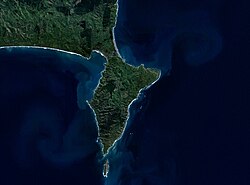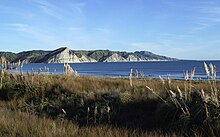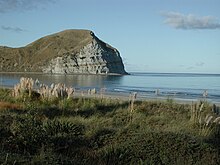Place in Hawke's Bay, New Zealand
| Māhia Peninsula | |
|---|---|
 NASA satellite image of Māhia Peninsula NASA satellite image of Māhia Peninsula | |
| Coordinates: 39°09′S 177°54′E / 39.150°S 177.900°E / -39.150; 177.900 | |
| Country | New Zealand |
| Region | Hawke's Bay |
| Territorial authority | Wairoa |
| Ward |
|
| Electorates | |
| Area | |
| • Total | 157.25 km (60.71 sq mi) |
| Time zone | UTC+12 (NZST) |
| • Summer (DST) | UTC+13 (NZDT) |
| Postcode | 4198 |
Māhia Peninsula (Māori: Te Māhia) is located on the east coast of New Zealand's North Island, in the Hawke's Bay region, between the towns of Wairoa and Gisborne.
It includes Rocket Lab's Launch Complex 1, located near Ahuriri Point at the southern tip of the Māhia Peninsula, for launching its Electron rockets.
Since 2018, it has been used as a commercial launcher of small satellites in the range of 135–235 kg, and miniature satellites called CubeSats. New Zealand's first orbital space launch took place from Launch Complex 1 on 21 January 2018.
Geography
The peninsula is 21.7 kilometres (13.5 mi) long and 11.3 km (7 mi) wide. Its highest point is Rahuimokairoa, 397 m (1,302 ft) above sea level. The peninsula was once an island, but now a tombolo joins it to the North Island.
Demographics
Māhia Beach, which is on the northeast coast of the peninsula, is described by Statistics New Zealand as a rural settlement. It covers 4.05 km (1.56 sq mi) and had an estimated population of 230 as of June 2024, with a population density of 57 people per km. It is part of the larger Mahia statistical area.
| Year | Pop. | ±% p.a. |
|---|---|---|
| 2006 | 240 | — |
| 2013 | 186 | −3.58% |
| 2018 | 183 | −0.32% |
| Source: | ||

Māhia Beach had a population of 183 at the 2018 New Zealand census, a decrease of 3 people (−1.6%) since the 2013 census, and a decrease of 57 people (−23.8%) since the 2006 census. There were 93 households, comprising 81 males and 99 females, giving a sex ratio of 0.82 males per female. The median age was 60.1 years (compared with 37.4 years nationally), with 21 people (11.5%) aged under 15 years, 12 (6.6%) aged 15 to 29, 84 (45.9%) aged 30 to 64, and 60 (32.8%) aged 65 or older.
Ethnicities were 68.9% European/Pākehā, 37.7% Māori, 1.6% Pacific peoples, and 1.6% Asian. People may identify with more than one ethnicity.
Although some people chose not to answer the census's question about religious affiliation, 36.1% had no religion, 50.8% were Christian, and 6.6% had Māori religious beliefs.
Of those at least 15 years old, 18 (11.1%) people had a bachelor's or higher degree, and 33 (20.4%) people had no formal qualifications. The median income was $24,900, compared with $31,800 nationally. 24 people (14.8%) earned over $70,000 compared to 17.2% nationally. The employment status of those at least 15 was that 48 (29.6%) people were employed full-time, 27 (16.7%) were part-time, and 3 (1.9%) were unemployed.
Mahia statistical area
Mahia statistical area, which includes Nūhaka, covers 471.97 km (182.23 sq mi) and had an estimated population of 1,270 as of June 2024, with a population density of 2.7 people per km. The peninsula itself covers 157.25 km (60.71 sq mi)
| Year | Pop. | ±% p.a. |
|---|---|---|
| 2006 | 1,272 | — |
| 2013 | 1,104 | −2.00% |
| 2018 | 1,119 | +0.27% |
| Source: | ||
Mahia had a population of 1,119 at the 2018 New Zealand census, an increase of 15 people (1.4%) since the 2013 census, and a decrease of 153 people (−12.0%) since the 2006 census. There were 456 households, comprising 552 males and 567 females, giving a sex ratio of 0.97 males per female. The median age was 49.0 years (compared with 37.4 years nationally), with 210 people (18.8%) aged under 15 years, 159 (14.2%) aged 15 to 29, 498 (44.5%) aged 30 to 64, and 252 (22.5%) aged 65 or older.
Ethnicities were 48.8% European/Pākehā, 64.9% Māori, 1.1% Pacific peoples, 0.8% Asian, and 1.3% other ethnicities. People may identify with more than one ethnicity.
The percentage of people born overseas was 4.8, compared with 27.1% nationally.
Although some people chose not to answer the census's question about religious affiliation, 35.4% had no religion, 49.3% were Christian, 8.3% had Māori religious beliefs and 0.8% had other religions.
Of those at least 15 years old, 126 (13.9%) people had a bachelor's or higher degree, and 207 (22.8%) people had no formal qualifications. The median income was $21,400, compared with $31,800 nationally. 78 people (8.6%) earned over $70,000 compared to 17.2% nationally. The employment status of those at least 15 was that 339 (37.3%) people were employed full-time, 150 (16.5%) were part-time, and 72 (7.9%) were unemployed.
History and culture
Māori history
In Maori legend, Whatonga, who came to New Zealand in search of his grandfather Toi, settled at Mahia.
The peninsula is the tribal area of the Ngāti Rongomaiwahine iwi. The word māhia means "indistinct sound" or "scrofulous swelling". The name "Te Māhia" comes from "Te Māhia-mai-tawhiti" (the sound heard from a distance).
Portland Island, also called Waikawa, is a small island off the southern tip of Mahia Peninsula. It was named Waikawa by Kahungunu when he visited there to look for fresh drinking water and only found salt water – Waikawa means "sour water". Portland Island has an unmanned lighthouse.
European history
Shore whaling was briefly important on the Mahia Peninsula. Early whalers had a whaling station on the farm "Kini Kini", sheltered by "Long Point" on the west coast of the peninsula. The peninsula community these days is still generally a mix of Maori and European.
Prime Minister Jacinda Ardern was proposed to by her partner, Clarke Gayford, on Mokotahi Hill.
Marae
There are five marae in the Mahia area affiliated with the hapū of Rongomaiwahine iwi:
- The Kaiuku or Oku-ra-renga Marae and its Kiwi meeting house are affiliated with the hapū of Ngāi Tama and Ngāi Tū
- Te Rākatō Marae is affiliated with the hapū of Ngāi Te Rākatō.
- Tuahuru Marae and its Hine te Rongo meeting house are affiliated with the hapū of Ngai Tama and Ngāi Tū.
- Ruawharo Marae is also affiliated with Ngai Tama.
- Mahanga Marae and its meeting house, Te Poho o Rongomaiwahine, are home to the hapū, Te Hokowhitu o Ngai Tu.
In October 2020, the Government committed $1,949,075 from the Provincial Growth Fund to upgrade 24 Ngāti Kahungunu marae, including both Kaiuku and Ruawharo Marae, creating 164 jobs. It also committed $102,644 to upgrading Tuahuru Marae, creating 4 jobs.
Economy

Sheep and cattle farms are an important part for the local community, but tourism is now the peninsula's main industry. Mahia's population swells greatly during the warmer months and in particular during school holidays.
Mahia is well known for its surf, scuba diving, hiking, and fishing. Morere Hot Springs is 15 minutes away, towards Gisborne. The area is a popular school holiday destination and contains a holiday park dating back to the 1960s. The remaining settlement consists mostly of holiday houses and baches.
From 2007 to 2010 Mahia became known for the presence of Moko, a dolphin.
The peninsula is the location of Rocket Lab Launch Complex 1, which has been used to launch spy satellites for the United States of America.
Education
Te Mahia School is a year 1–8 co-educational state primary school. It is a decile 1 school with a roll of 69 as of November 2024. The school opened in 1917.
Climate
| Climate data for Mahia (1991–2020 normals, extremes 1990–present) | |||||||||||||
|---|---|---|---|---|---|---|---|---|---|---|---|---|---|
| Month | Jan | Feb | Mar | Apr | May | Jun | Jul | Aug | Sep | Oct | Nov | Dec | Year |
| Record high °C (°F) | 32.6 (90.7) |
34.9 (94.8) |
30.9 (87.6) |
26.5 (79.7) |
26.0 (78.8) |
21.0 (69.8) |
20.6 (69.1) |
21.5 (70.7) |
22.5 (72.5) |
26.4 (79.5) |
28.1 (82.6) |
30.0 (86.0) |
34.9 (94.8) |
| Mean daily maximum °C (°F) | 21.8 (71.2) |
21.7 (71.1) |
20.2 (68.4) |
17.9 (64.2) |
15.8 (60.4) |
13.5 (56.3) |
12.7 (54.9) |
13.2 (55.8) |
14.9 (58.8) |
16.7 (62.1) |
18.1 (64.6) |
20.1 (68.2) |
17.2 (63.0) |
| Daily mean °C (°F) | 18.4 (65.1) |
18.6 (65.5) |
17.1 (62.8) |
15.1 (59.2) |
13.2 (55.8) |
11.0 (51.8) |
10.3 (50.5) |
10.5 (50.9) |
11.9 (53.4) |
13.4 (56.1) |
14.8 (58.6) |
16.8 (62.2) |
14.3 (57.7) |
| Mean daily minimum °C (°F) | 14.9 (58.8) |
15.4 (59.7) |
14.1 (57.4) |
12.3 (54.1) |
10.5 (50.9) |
8.5 (47.3) |
7.8 (46.0) |
7.9 (46.2) |
8.9 (48.0) |
10.1 (50.2) |
11.4 (52.5) |
13.5 (56.3) |
11.3 (52.3) |
| Record low °C (°F) | 7.3 (45.1) |
6.0 (42.8) |
6.0 (42.8) |
4.6 (40.3) |
1.3 (34.3) |
2.5 (36.5) |
0.5 (32.9) |
0.6 (33.1) |
2.0 (35.6) |
3.0 (37.4) |
4.3 (39.7) |
5.9 (42.6) |
0.5 (32.9) |
| Average rainfall mm (inches) | 53.6 (2.11) |
67.3 (2.65) |
89.6 (3.53) |
97.4 (3.83) |
99.7 (3.93) |
123.6 (4.87) |
143.6 (5.65) |
101.1 (3.98) |
70.2 (2.76) |
69.6 (2.74) |
72.5 (2.85) |
68.3 (2.69) |
1,056.5 (41.59) |
| Source: NIWA | |||||||||||||
References
![]() Media related to Māhia Peninsula at Wikimedia Commons
Media related to Māhia Peninsula at Wikimedia Commons
- ^ "ArcGIS Web Application". statsnz.maps.arcgis.com. Retrieved 29 January 2023.
- "NZGB Gazetteer". gazetteer.linz.govt.nz. Retrieved 15 December 2020.
- Whaanga, Mere (10 February 2015). "Ngāti Rongomaiwahine – Māhia Peninsula". Te Ara – the Encyclopedia of New Zealand. Manatū Taonga Ministry for Culture and Heritage. Retrieved 8 February 2018.
- Rocket Lab Plans Electron Test Launches This Year. Jeff Foust, Space News. 19 April 2016.
- "Destination: Mahia Peninsula". The New Zealand Bay Fisher. Ink IQ. Retrieved 8 February 2018.
- "Aotearoa Data Explorer". Statistics New Zealand. Retrieved 26 October 2024.
- ^ "Statistical area 1 dataset for 2018 Census". Statistics New Zealand. March 2020. 7015775.
- "Aotearoa Data Explorer". Statistics New Zealand. Retrieved 26 October 2024.
- ^ "Statistical area 1 dataset for 2018 Census". Statistics New Zealand. March 2020. Mahia (207900). 2018 Census place summary: Mahia
- "Story: Ngāti Rongomaiwahine".
- Williams, Herbert W. (1971). "Māhia". A Dictionary of the Maori Language (7th ed.). p. 163.
- "Shore-based whaling". Te Ara. Retrieved 22 May 2017.
- Shortt, Bill (7 February 2016). "Mahia takes the cake". The Gisborne Herald. Retrieved 8 February 2018.
- Bateman, Sophie (6 May 2019). "PM Jacinda Ardern spills details on 'very romantic' proposal". Newshub. Archived from the original on 6 May 2019. Retrieved 15 December 2020.
- "Te Kāhui Māngai directory". tkm.govt.nz. Te Puni Kōkiri.
- "Māori Maps". maorimaps.com. Te Potiki National Trust.
- "Marae Announcements" (Excel). growregions.govt.nz. Provincial Growth Fund. 9 October 2020.
- "Mahia Travel Guide". Jasons Travel Media.
- Strout, Nathan (18 June 2020). "US to continue launching spy satellites from New Zealand in 2021". C4ISRNet. Retrieved 17 April 2022.
- "Ministry of Education School Profile". educationcounts.govt.nz. Ministry of Education.
- "New Zealand Schools Directory". New Zealand Ministry of Education. Retrieved 1 January 2025.
- "Education Review Office Report". ero.govt.nz. Education Review Office.
- Te Mahia School 75th jubilee and Tawapata School reunion magazine. Te Mahia School. 1992. OCLC 154770552.
- "CliFlo – National Climate Database : Mahia Aws". NIWA. Retrieved 14 September 2024.
| Wairoa District, New Zealand | |
|---|---|
| Seat: Wairoa | |
| Populated places | |
| Geographic features | |
| Facilities and attractions | |
| Government | |
| Organisations | |
| History | |